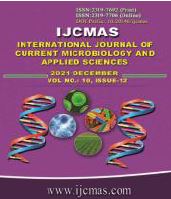


 National Academy of Agricultural Sciences (NAAS)
National Academy of Agricultural Sciences (NAAS)

|
PRINT ISSN : 2319-7692
Online ISSN : 2319-7706 Issues : 12 per year Publisher : Excellent Publishers Email : editorijcmas@gmail.com / submit@ijcmas.com Editor-in-chief: Dr.M.Prakash Index Copernicus ICV 2018: 95.39 NAAS RATING 2020: 5.38 |
Peanut late leaf spot (Cercosporidium personatum) [Berk.and Curtis] Deighton]) caused yield losses worldwide. An analysis of the genetic effects of resistance to late leaf spot on peanut in a full diallel was performed using Griffing (1956) and Hayman (1954) methods. The objective of the study was to analyse the genetic potential of six parental lines and to determine through severity score and percent defoliation how resistance was transmitted to their descendants. The study found that the severity score gives a broad-sense heritability of 90.2% and a narrow-sense heritability of 70.8%. Defoliation indicated broad-sense heritability of 39% and a narrow-sense heritability of 40.6%. Graphical analysis revealed that resistance to the disease may arise from a complex of dominant and recessive genes. GCA, SCA and Reciprocal Combining Effect was highly significant for the severity score and no significant for defoliation. Additivity have a preponderant influence on the resistance gene expression and severity score appear to be first choice trait in the diallel analyzes for resistance. This severity score better reflected resistance it was more heritable and could be a trait of choice in the breeding strategy to improve resistance to late leaf spot. NAMA, PC79-79, GM656 could be recommended in hybridization programs aimed at improving resistance to late leaf spot.
Neya Bawomon Fidèle, Thio Ibié Gilles, Dabire Tobdem Gaston, Nana Toundwensida Abel, Koita Kadidia, Zagre M’BI Bertin and Sankara Philippe. 2021. Diallel Analysis of Severity Score and Defoliation Percent of Late Leaf Spot (Cercosporidium personatum) [Berk.and Curtis] Deighton]) on Peanut (Arachis hypogaea L).
Int.J.Curr.Microbiol.App.Sci. 10(12): 283-296. doi: https://doi.org/10.20546/ijcmas.2021.1012.033 |
 |
 |
 |
 |